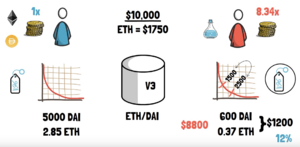Uniswap: Difference between revisions
Jump to navigation
Jump to search

(Created Uniswap page) |
(Regurgitated some of the concepts on the Uniswap page, and Finematics.) |
||
| Line 1: | Line 1: | ||
== How it works? == | == How it works? == | ||
=== | === Overview === | ||
<blockquote>Uniswap is an ''automated liquidity protocol'' powered by a constant product formula and implemented in a system of non-upgradeable smart contracts on the Ethereum blockchain.<ref>''Protocol Overview: How Uniswap works''. (n.d.). Uniswap. Retrieved November 8, 2023, from <nowiki>https://docs.uniswap.org/contracts/v2/concepts/protocol-overview/how-uniswap-works</nowiki></ref></blockquote> | |||
== Timeline == | |||
=== Version Evolution === | |||
| | {| | ||
! | ! | ||
!V1 | !V1 | ||
| Line 18: | Line 19: | ||
|- | |- | ||
|V2 | |V2 | ||
|Solidity: ETH20-ETH20 | |||
| | | | ||
|NA | |NA | ||
|- | |- | ||
| Line 29: | Line 30: | ||
* Focuses on capital efficiency | * Focuses on capital efficiency | ||
|} | |} | ||
Concentrated Liquidity | |||
== Concepts == | |||
=== Liquidity Pools === | |||
=== Swaps === | |||
=== Constant Product Formula === | |||
<code>x * y = k</code> | |||
=== Concentrated Liquidity (CL) === | |||
As long as the pairing of ETH and DAI stay within a range ($1500-2500), User Red who invested much less than User Blue ($1200 vs. $10,000) can still earn the same trading fees (see Figure CL). | |||
[[File:Uniswap concentrated-liquidity-example.png|thumb|Figure CL: An example of how Uniswap V3's concentrated liquidity concept works.<ref>''UNISWAP V3 - New Era Of AMMs? Architecture Explained''. (2021, March 23). Finematics. Retrieved November 8, 2023, from <nowiki>https://finematics.com/uniswap-v3-explained/</nowiki></ref>]] | |||
=== Active Liquidity === | |||
=== Range Limit Orders === | |||
== Questions == | == Questions == | ||
# How does the relate to DGF? | # How does the relate to DGF? | ||
## Can it help with validation pool REP management and redistribution? | ## Can it help with validation pool REP management and redistribution? [Context: Odra Collaboration] | ||
### | ### REP and cryptocurrencies are fundamentally different. REP is meant to be a low velocity asset that has non-fungible qualities. | ||
== References == | == References == | ||
<references /> | |||
Revision as of 13:48, 8 November 2023
How it works?
Overview
Uniswap is an automated liquidity protocol powered by a constant product formula and implemented in a system of non-upgradeable smart contracts on the Ethereum blockchain.[1]
Timeline
Version Evolution
| V1 | V2 | V3 | |
|---|---|---|---|
| V1 | Vyper: ETH20-ETH | NA | NA |
| V2 | Solidity: ETH20-ETH20 | NA | |
| V3 | Ethereum and Optimism | Concentrated Liquidty, Active Liquidity, Range Limit Orders.
|
Concepts
Liquidity Pools
Swaps
Constant Product Formula
x * y = k
Concentrated Liquidity (CL)
As long as the pairing of ETH and DAI stay within a range ($1500-2500), User Red who invested much less than User Blue ($1200 vs. $10,000) can still earn the same trading fees (see Figure CL).

Figure CL: An example of how Uniswap V3's concentrated liquidity concept works.[2]
Active Liquidity
Range Limit Orders
Questions
- How does the relate to DGF?
- Can it help with validation pool REP management and redistribution? [Context: Odra Collaboration]
- REP and cryptocurrencies are fundamentally different. REP is meant to be a low velocity asset that has non-fungible qualities.
- Can it help with validation pool REP management and redistribution? [Context: Odra Collaboration]
References
- ↑ Protocol Overview: How Uniswap works. (n.d.). Uniswap. Retrieved November 8, 2023, from https://docs.uniswap.org/contracts/v2/concepts/protocol-overview/how-uniswap-works
- ↑ UNISWAP V3 - New Era Of AMMs? Architecture Explained. (2021, March 23). Finematics. Retrieved November 8, 2023, from https://finematics.com/uniswap-v3-explained/